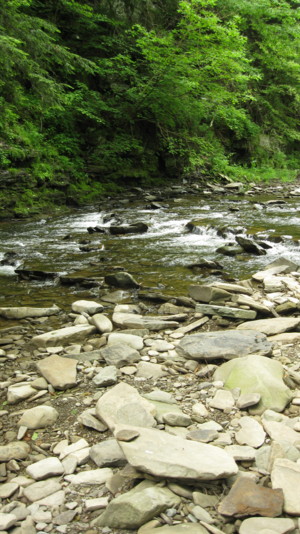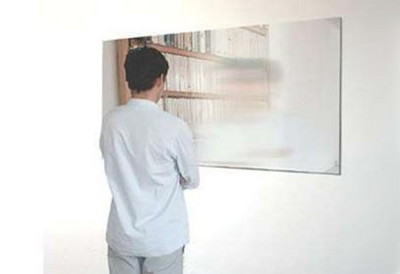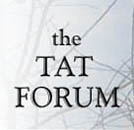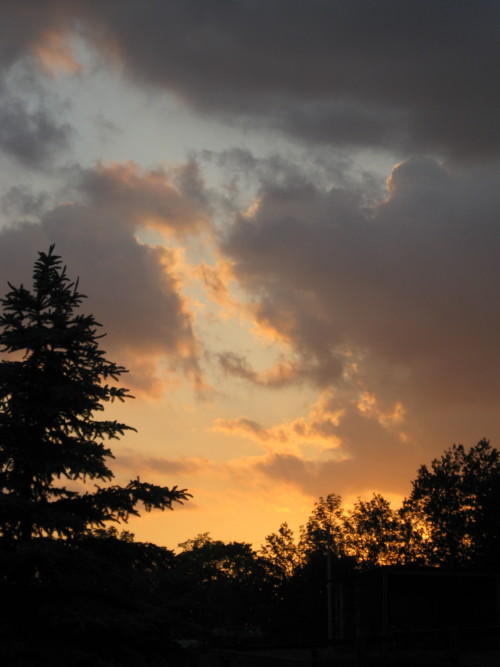January 2012
This Month's Contents: Seeking and Headlessness by Carl Laurence | Meditation by Sunil Vidyarthi | On the WAY by Eloratea | The Divided Brain by Iain McGilchrist | Form is Emptiness by Wyatt Wright | Longing Empowers Change by Topi Piirainen | Humor | Reader Commentary | Who I Am, Before Birth, Eternally
Editor's Note
by David Weimer
A very spiritual athiest friend of mine sent this to me recently...
Happy New Year, and welcome to the TAT Forum.
Seeking and Headlessness
by Carl Laurence
Introduction
This writing was inspirited by a suggestion from an awakened teacher. The thoughts are originally from this writer's 20-minute talk presented in 2011 at a Self-Inquiry Group (SIG) Retreat in Raleigh, North Carolina. That talk can be found (along with talks from some truly awakened folks) at www.selfinquiry.org.
The broad theme of our three-day Retreat was The Paradox of Spiritual Effort. And three "seekers" in our group (a/k/a: "not teachers") were asked to give presentations about "What has changed on my spiritual path recently?" Mine was one of those.
The context of my use of such terms as "spiritual path" and "spiritual seeking," or "spiritual effort" comes from this introductory explanation found on selfinquiry.org:
Most people who continue to come to our meetings are not concerned with "Why should I seek Self-realization?" but rather, "What is the best way to go about it?" There is a paradox in that we use words to talk about that which is beyond words, and although there is often talk of paths and things to do, there is also general agreement that the best approach is subtractive. That is, rather than try to accumulate more spiritual and worldly knowledge, to doubt the truth of all you think you already know.
Nothing Personal
This writer calls himself a "spiritual seeker." And I've been on a "spiritual path" for over 40 years. But in December 2010, a complete "shift" occurred while "futzing around" on that alleged spiritual path. In a twinkling, there was an "absence" in place of the "seeker." It was mind-boggling in an unprecedented way. And yet there was no fuss, no birthday cake and candles. Words are tricky, but here is what is seen: The person we think ourselves to be is just a story. There is no "person". Of course, that's pretty much what all the great teachers say. But this time there was some sort of "seeing." Looking was just happening without any help from me. There was no "head;" nobody to claim that this was his experience.
Spiritual teacher Douglas Harding named this shift in seeing—headlessness. Christian (and non-dual) teacher Bernadette Roberts calls it the experience of "no-ego." And in branches of the Zen Buddhist tradition, it might be called a "satori." The images conjured by the term "paradigm shift" also might work as a descriptor.
So, fellow seeker, why read this account if the same essence can be gathered from famous teachers? Well… I'm still in the lightweight division like most of the seekers I know. I'm not "done," as many curiously claim. This account is intended to come from an on-going seeking perspective.
Click here to continue reading Carl's intriguing personal essay.
Meditation
by Sunil Vidyarthi
Recently I was watching a TVO (Ontario version of PBS) special on Buddha and his life. After enlightenment and delivering a series of sermons, his fame reached the ears of a local king of Rajgir. He donated some land and a bamboo orchard to the monk which became Buddha's home for the rest of his days. When he was not traveling the globe, he would frequently return to Rajgir and often spend considerable time meditating in a cave still maintained on this ashram. In addition to a deep interest in visiting this cave next time I am in the vicinity which is not very far from my ancestor's farm, I was intrigued by what meditation did this all time great leader, perhaps the inventor of modern day meditation do after accomplishing everything possible through meditation?
I have asked this question to some of my friends and gurus who are obviously enlightened. What if any meditation do they do now? Answers have been generally "none" to "that once you have seen the truth, all of life becomes meditation." So what was Buddha up to in this cave?
 Upon meditating on this question and having some forty years of
meditation experience myself, I think I have a reasonable hypothesis
as to Buddha's activities in that cave. This is of course based on my
experience and speculation.
Upon meditating on this question and having some forty years of
meditation experience myself, I think I have a reasonable hypothesis
as to Buddha's activities in that cave. This is of course based on my
experience and speculation.
Not all meditation is the same. The act may be similar but objectives determine what meditation you need to do. This is quite critical as I found out that wrong objectives end up producing wrong results. Not surprising since all of this is still conducted by the mind and that instrument is notorious for delivering what you ardently desire. So, if you have been meditating on the laws of attraction expecting nirvana to grace your soul, you could be waiting a long time. Most meditators in fact have been waiting.
Hindu children go through a thread ceremony which is akin to a coming of age event. During this process, one is blessed with a mantra, commonly the gayatri and takes a vow to recite this in meditation for ten to twenty minutes each day for the rest of one's life. I did this in earnest for nearly forty years. I do believe meditation was beneficial to me while I completed my academic studies as well as employment but was entirely unhelpful in producing what I was really looking for. What anyone is looking for, happiness! This prompted me to abandon meditation and led me to searching other avenues including my introduction to spiritual guides including Buddha, Krishnamurti and Richard Rose.
To my surprise, most masters also recommended meditation, leading me to great deal of confusion as to what meditation should I be doing but was not. The meditation of Krishnamurti or the effortless meditation in TM were quite different from the ones prescribed by the Hindu priests. Theirs was more of a prayer to the divine in the form of deities while masters like Buddha taught vipassana, a process of simply watching your body and breath. Many of Tibetan practice of Buddhism seems similar to Hindu worship than vipassana. Reverence to statues, objects and scripture is far more religious than philosophical.
Then there is advaita and new age movement that is sweeping the world. I attended a two week intensive with the gurus and guides at the oneness university in chennai. Their form of meditation turned out to be yet another kind. The central focus there and at many similar ashrams is to enhance vital energy. This is called Kundalini by the Indians, qi by the Chinese, and ki by the Japanese. So how do you build this energy within yourself? Why, mediation of course.
This enormous field of mind, body, consciousness and soul connection through an act that looks similar but is quite different, that is the act of meditation. Meditation being a physical act although mimicking something different is still controlled and influenced by the mind and body complex we have evolved into. Like nearly every act mind performs, the biggest influencer turns out to be intent. I personally have come into contact with three types of meditation so far. There may be more but arguably would fall into one of these three.
What I personally started doing initially was Practical Meditation, a discipline designed by our ancestors for physical and material success. Even though it is fully steeped in Vedas, religion and philosophy, the intent simply is to make sure my brain functioned optimally to do life. And it was very successful as a tool to help me accomplish physical and mental tasks. Most often, the spiritual intent is absent in practical meditation hence no such success is achieved. I was still an unhappy and unfulfilled person even though materially sound.
The second type of meditation I stumbled onto was the result of an intent to find a solution to this anhedonic feeling; finding no peace nor happiness. The internal cry of "there has to be something more to life than just this" kept pushing me to look. This "Analytical Meditation" kept Buddha returning to his cave in Rajgir, recharge and come up with solutions to myriad of questions he faced over the years. Buddha was a genius with an unparalleled insight into the human condition.
Finally, a third type of meditation is often called "shaktipat or energy meditation." This is what Richard Rose referred to as betweenness and was used by masters to perform miracles, like Jesus turning water into wine, yogis walking on water and the mundane deeksha process practiced by the oneness crowd in Chennai. Reiki and Qi Gong are also energy meditation.
Personally I no longer do practical meditatioon as I find very little in the material world of desire to strive for. I am however very grateful to my guru who introduced me to this while I was trying to make a living. I would still recommend it, particularly to younger yogis. My practice today combines the analytical and energy meditation. Analytical because if Buddha did this even long after becoming the model of enlightenment, who am I to question this practice. I suppose this will continue for life. Finally I am very attracted to shaktipat perhaps this is yet another form of desire. But I am not going to question what is obviously the most blissful of all meditation practices I have tried.
There are many other types of meditation like astral projection, concentration, hatha yoga and kundalini. I have tried a few of these but they are merely different techniques used to deliver practical, analytical or shaktipat results.
~ Contact .
On the WAY
by Eloratea
|
Today I woke up with only one aim—
Today, while I was walking that way, something happened.
I don’t know if it is a rare mystery,
|
Read and encounter more of this poet's perspective at their blog.
The Divided Brain
by Iain McGilchrist
If you don't see a video clip above, go directly to youtube.com
Form is Emptiness: The Mirror Aspect of Douglas Harding's Pointing Experiment
by Wyatt Wright
 While conducting Douglas Harding’s “Pointing Here” experiment, and drawing the attention back to right here where I am when the finger is pointing Here, I certainly can’t argue that where the finger is pointing has no attributes and is utterly empty capacity or space for all attributes of the world.
While conducting Douglas Harding’s “Pointing Here” experiment, and drawing the attention back to right here where I am when the finger is pointing Here, I certainly can’t argue that where the finger is pointing has no attributes and is utterly empty capacity or space for all attributes of the world.
However, one aspect of this continues to draw my attention and tickle the curiosity with sensations of strangeness. It is the aspect of noticing this space is simultaneously full of the current scene including the pointing finger. The best descriptor that pops up for this is the mirror aspect of self-pointing, since the finger is also pointing to where the finger IS or the finger is pointing at itself!
Another way to put this is that the finger simultaneously “overlays” the space it is pointing to. Once while conducting this experiment with friends and sharing this strange mirroring, I picked up a cup and held it with my free hand close behind the pointing finger. Sure enough, suspicions were confirmed as the cup was behind the finger “out there” while simultaneously being pointed to right HERE!

|
Quotes...."Longing is a desire. A desire for something more, for something that might bring meaning or happiness. Just the fact that I acknowledged it and allowed myself to feel it has changed me. "Lately more than ever that desire has started to overtake other desires. I think that this means that the desire for meaning is getting stronger than other, lesser, desires. Things I used to get entertained by seem meaningless and empty..." ~ Read more of this earnest essay at Topi Piirainen's blog.
|
Humor....
is not what it does when it works
but what it does when it’s stuck.
~Marvin Minsky
Reader Commentary
Wonderful December 2011 issue, thank you for the gift.
~Camilla in Stockholm
And now:
Did you enjoy the Forum? Then buy the book!
Beyond Mind, Beyond Death
is available at Amazon.com.




